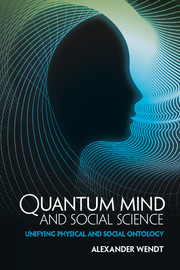Book contents
- Frontmatter
- Dedication
- Epigraph
- Contents
- Acknowledgments
- 1 Preface to a quantum social science
- Part I Quantum theory and its interpretation
- 2 Three experiments
- 3 Six challenges
- 4 Five interpretations
- Part II Quantum consciousness and life
- Part III A quantum model of man
- Part IV Language, light, and other minds
- Part V The agent-structure problem redux
- Conclusion
- Bibliography
- Index
2 - Three experiments
from Part I - Quantum theory and its interpretation
Published online by Cambridge University Press: 05 May 2015
- Frontmatter
- Dedication
- Epigraph
- Contents
- Acknowledgments
- 1 Preface to a quantum social science
- Part I Quantum theory and its interpretation
- 2 Three experiments
- 3 Six challenges
- 4 Five interpretations
- Part II Quantum consciousness and life
- Part III A quantum model of man
- Part IV Language, light, and other minds
- Part V The agent-structure problem redux
- Conclusion
- Bibliography
- Index
Summary
Quantum theory is a mathematical formalism that allows physicists to predict the probability of observing different outcomes in experiments on sub-atomic systems. It has been tested more rigorously than any theory in science, and has never been wrong. However, strictly speaking it does not “explain” the behavior of sub-atomic systems, since it does not propose a mechanism to account for it. It tells us that they will behave in certain ways, but not why. Thus, quantum mechanics is not a theory in the sense familiar to social scientists, namely a body of laws that explains some part of reality. The explanatory question is the subject of the interpretive debates that surround the theory, not of the theory per se. That said, the literature routinely refers to quantum mechanics as a theory, and I shall use the terms interchangeably below.
A common way to introduce quantum theory is through some of the key experiments that have confirmed its predictions. In this chapter I describe three of the most well-known: the Two-Slit Experiment, the Bell Experiments, and the Delayed-Choice Experiment. While painting the same overall picture, each reveals distinct features of the quantum realm. While their interpretation is contested, here I will do my best to present just the theory's findings, saving interpretive questions for later.
The Two-Slit Experiment
This experiment actually had its origins long before the quantum revolution. One of the most controversial questions in classical physics was whether light was made of particles or waves. In keeping with his atomistic worldview, Newton favored the particle or “corpuscular” theory of light, which was the majority view among physicists through the eighteenth century. However, in 1801 Thomas Young performed an experiment that seemed to prove conclusively that the wave theory was correct.
In his experiment, Young set up a light source behind an opaque screen with one small opening or slit, through which the light passed in a concentrated beam.
- Type
- Chapter
- Information
- Quantum Mind and Social ScienceUnifying Physical and Social Ontology, pp. 43 - 57Publisher: Cambridge University PressPrint publication year: 2015

